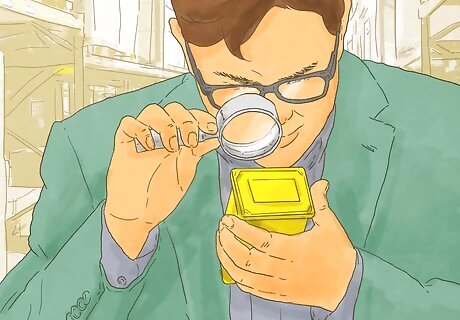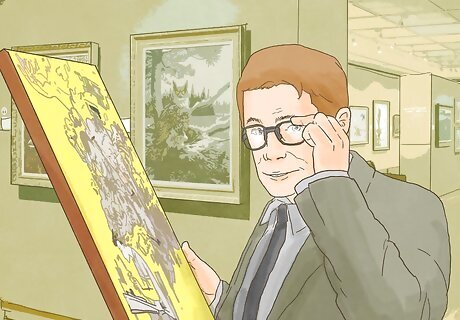
views
Learning About the Art World

Research the job demands. Art brokers work long, irregular hours, and often do all the work running their gallery or office. Most brokers work on commission, so pay can be irregular as well. Brokers also attend functions, shows, and meetings at all hours. Spend some time searching online or talking to gallery owners or art professors in the area.

Learn about art. Art brokers don’t need to have college degrees, but they do need to have a very broad education in art, especially art history. If you don’t have an art background, educate yourself by reading everything you can about art history, attending every art museum or gallery you can, and going to art lectures and art show openings in your area. Ask your library and local college for reading recommendations. If you know anyone in the art world, ask them about their favorite books, museum catalogs, and websites.

Become a good salesperson. A good art broker is also a good salesperson. They need to convince the owner of a work of art that it should be sold, that they are the best broker to sell their work, and that they deserve their full commission. They then need to persuade someone else that the artwork is the perfect piece for them. Sales is an essential skill, and many art brokers have backgrounds in business and marketing. Apply for sales positions at local stores and companies to get some practice. If you don’t have a sales background, research sales pitches online and practice them on your friends and family.

Choose a specialization. Every art broker has a specialty. Choose a genre, artist, location, or time period in art history, and make that the focus of your business. Most of the art you broker will fall into your specialization. Choose a specialty that you love rather than a lucrative speciality. Trends in the art world can be unpredictable, and you will have to be very enthusiastic about the art you’re selling. If you hate Japanese woodcuts you won’t enjoy selling them. You should also choose a specialty that will let you support a business in your area. If you live in a big arts city like New York, you can pick something very obscure, like fifteenth-century Russian icons. If you live in a smaller town far away from a major arts center, you can choose something much broader, like modern American art.

Research your specialization. Once you know what you want to specialize in, learn everything you can about it. Read every major book on the subject, look up where the prominent collections are, and go to every event or lecture related to your speciality. If you aren't sure what to read, try asking your local library or college's art history department for recommendations. You can also search online for a syllabus about your subject. These will have a great mix of classic works and cutting-edge research on your specialty.

Know the major players in your area. Find out who are the major figures in your area’s art scene. You’ll need to know about other brokers, prominent local artists, major collectors and museums in the area, and important galleries. A good place to begin your research is your local college’s art department, which will have connections to the local art world. Don't be afraid to introduce yourself to people working in galleries, museums, and art collectives. People who love art usually love talking about art! Search social media event pages for local art events. The people coordinating and hosting them are usually very involved in the art world.
Networking

Apply for jobs or internships. A job in the art field can increase your prestige and credibility with prospective clients. If you’ve never worked in art before, try to get a job or internship at a local gallery, museum, or artists’ collective. If you have a college degree in any area, contact your school’s alumni association for help finding openings. If that isn’t an option, introduce yourself to local gallery owners and museum workers and inquire about job openings. If there are no arts jobs available in your area, volunteer at a museum or gallery!

Visit art shows. Become a regular attendee at art shows--your local gallery will often have a calendar of events, or you can search social media. Prioritize your local shows, but if you are able to travel, go to everything related to your specialty that you can. Talk to anyone you can at these shows. They’re great places to meet collectors and artists.

Attend arts or community events. Many art collectors are actively involved in community events and the larger arts world. Go to museum exhibit openings, lectures, arts fundraisers, and any event you know prominent arts figures will be attending. Social media is a great way to track attendees and find out what the next big arts event is.

Get to know artists or owners in your specialization. Once you’re familiar with your local arts scene, focus on getting to know prospective clients who create or collect art in your chosen speciality. Ask friends and colleagues involved in art if they know anyone involved with your focus area, and introduce yourself to everyone connected with your specialty. Reach out to people via social media! If you focus on contemporary art, be sure to speak to artists at shows and give them your contact information. Many art buyers are actually corporations looking for investments! Don’t forget to research companies that have shown an interest in art collecting. To get started, do an online search for corporate art buyers in your area.
Starting Your Own Brokerage

Establish a client base of buyers and sellers. Ask people you know who are interested in your specialty if they are considering buying or selling art. Emphasize your knowledge and credentials to them, and use your sales pitch to convince them that you are the best broker for them. Selling a work of art requires you to convince the buyer that the artwork is a good investment and is perfect for them. Learn your client’s preferences before you show them anything, and be prepared to explain why a work of art is high-quality. If you work directly with artists to sell their work, focus on establishing a permanent partnership with them. Most brokers display an artist’s work in exchange for a commission when it sells, so an ongoing partnership with a prolific artist can be very profitable.

Find investors. Being a successful art broker requires investment capital. You’ll need to pay for a gallery or office, travel expenses to shows and meetings, and routine business expenses like internet access and office supplies. Apply for a loan at your local bank. If you have important connections in the art world, they may be willing to invest in your brokerage. Ask your family to invest if they can.

Open a gallery or office. You’ll need a place to conduct business. Most art brokers operate out of their own galleries, which allows clients to see available art. You can even get walk-in clients using the gallery model. Other brokers operate out of offices, especially if they specialize in selling art to corporate clients. You may be able to rent gallery space from an existing gallery or artists’ collective. If there is an arts district in your town, try to establish your gallery there. Choose a location that allows for lots of foot traffic--many buyers aren't necessarily collectors, but local people who simply saw something they liked. Good locations include downtown streets, boardwalks, and town centers. Be sure to submit all plans to your investors before signing a lease or buying a property.

Consider purchasing art to sell. Many brokers buy art directly from artists or other collectors and then sell it elsewhere for a profit. This can be more lucrative than simply collecting a commission. If you have the available capital, consider buying art to sell directly. Buying directly from an artist or collector rather than another broker will increase your profit margins. Be sure to buy art in your specialty. You may make a poor investment if your first art purchase is in a genre you are less familiar with.




















Comments
0 comment